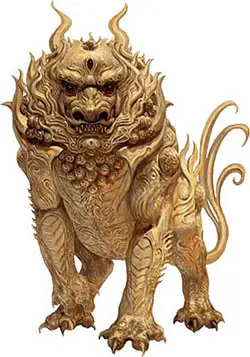
At the start of the game, the player whose Clan is at the top of the Honor track takes the deck of Political Mandates to play the first Mandate Turn.
At the start of the following Seasons, the first player to perform a Mandate Turn is the one to the left of the player who performed the last Mandate Turn on the previous Season.
To easily remember this, make sure to keep the deck of Political Mandates close to the player who will play it next.
During a Mandate Turn, the player currently in possession of the deck of Political Mandates draws the top 4 Mandate tiles and looks at them in secret. They choose 1 of the Political Mandates and returns the other 3, facedown, to the top of the deck, without reshuffling.
They then place the chosen Political Mandate faceup on the first available Political Mandate slot on the board (from left to right) for all players to see what Mandate will be executed this turn.
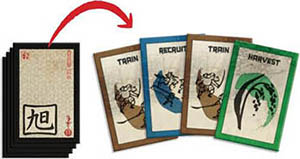
Example: The current player draws 4 tiles from the top of the Mandate deck.
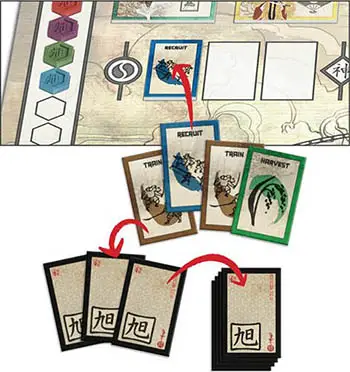
Example: The current player decides to play Recruit, returning the rest facedown to the top of the deck.
The chosen Political Mandate is performed by all players, starting with the player to the left of the player who selected it and proceeding clockwise. The player who selects a Mandate will therefore be the last to perform it (except for the Train Mandate, see page 16). The effects of each Political Mandate are summarized on the Political tile each player has behind their Clan screen. Except for the Betray Mandate, all Mandates have 2 components: One part that ALL PLAYERS may perform and one Bonus part that only the CURRENT PLAYER AND THEIR ALLY (if they have any) may perform.
One by one, in clockwise order, each player performs the chosen Mandate. Only the player who selected it and their Ally are allowed to also perform the Mandate's Bonus. This goes on until all players have performed the Mandate.
Once the current Mandate Turn is over, the current player passes the facedown deck of remaining Political Mandates to the player to their left, who becomes the next current player and executes the next Mandate Turn (unless the Political Track indicates a Kami Turn must be performed next).
Let's explore each of the 5 Political Mandates a player may be able to select.
Recruit
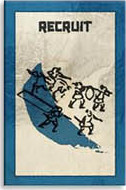
The Recruit Mandate allows players to place more of their figures on the board, bolstering their armies. The player who choses this Mandate gets to decide last where to place their figures, first seeing what their opponents do.
All Players
The player may Summon 1 of the figures they have in reserve to each of the Provinces where they have a Stronghold. So, for example, if a player has 3 Strongholds on the Map, they may Summon up to 3 different figures, and they must each be placed in the Provinces that contain those Strongholds.
A player may have more than 1 Stronghold in the same Province, in which case they may Summon a number of figures to that Province equal to the number of Strongholds they have there. There is no limit to the number of figures that may occupy each of the Provinces. If the player has no more figures in their reserve, they cannot Summon another figure.
Current Player And Their Ally
The player may Summon 1 additional figure to any one of their Strongholds, even if they have already Summoned a figure there.
Negotiation Tip
Recruiting when you have more Strongholds than your opponents means you get more figures than them. Bribing another player to play this Mandate when it 's the most beneficial for you is worth a shot.
Once you commit a Shinto to a Shrine, it will be there for the rest of the Season. It might be best to first negotiate with your Ally who will worship which Kami, so you don't end up wasting a Shinto needlessly.
Summoning Shinto

When a Shinto warrior is Summoned (and only at the moment when it is Summoned), the player may choose to send it to climb the holy mountains to Worship one of the Kami . If they choose to do so, the Shinto is immediately taken from the Province where it was Summoned and placed on any of the 4 Shrine tiles on the top of the board . There is no limit to the number of Shinto figures that may occupy each of the Shrines.
A Shinto worshipping at one of the Shrines is not considered to be on the Map . It cannot be Moved to the Map or to a different Shrine.
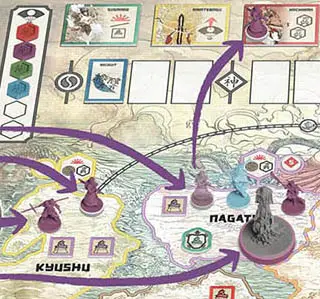
Example: The LOTUS player plays Recruit. After all other players have performed the Mandate, the LOTUS player performs it. Since they have 3 Strongholds on the Map (2 in Kyushu and 1 in Nagato), they may Summon a total of 4 figures (1 in each Stronghold, and an extra 1 in a Stronghold due to the Mandate Bonus). The player decides to Summon a Bushi and a Shinto in the Kyushu Strongholds, a Shinto in the Nagato Stronghold, and for the Bonus, they Summon the Yurei Monster they had in reserve to Nagato. They then decide to send the Nagato Shinto to worship Hachiman in his Shrine.
Marshal
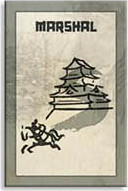
The Marshal Mandate allows players to Move their figures around the Map, according to their strategies. It may also allow players to build new Strongholds in order to establish their footholds. If you play Marshal, you get to decide where to move your figures after your opponents.
All Players
The player may Move each of the figures they have on the Map to an adjacent Province. This means either crossing a Border or taking a Shipping Route to Move to an adjacent Province. The player may choose to Move any number of their figures and may even choose not to Move any of them, if they so desire. But keep in mind that each figure can only be Moved once during each Marshal Mandate.
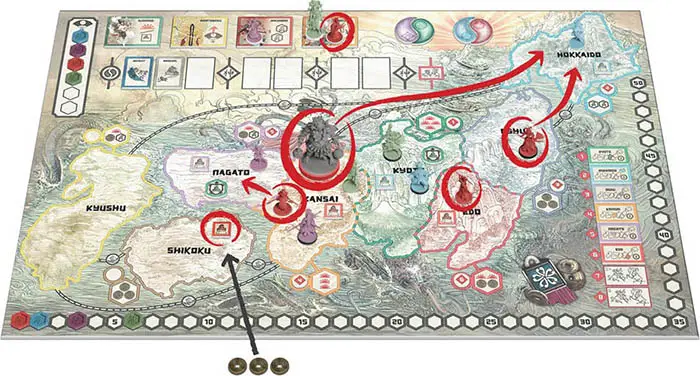
Example: The DRAGONFLY player plays Marshal, so they will perform it last. Going around the table, the KOI player gets to execute their Marshal actions. They Move a Bushi from Kansai to Nagato, crossing a Border. They also move their Oni of Blood and Daimyo to Hokkaido, using Shipping Routes. They decide not to Move the Bushi in Edo and wouldn't be allowed to Move the Shinto which is in the Raijin Shrine (figures on the Shrines can never be Moved). Finally, since they are Allied with the DRAGONFLY Clan, who chose the Mandate, they get to perform the Marshal Bonus, spending 3 Coins to build a new Stronghold in Shikoku.
Negotiation Tip
It's an advantage to win a battle you don't even have to fight. When moving your figures around, try to make deals with other players so there might be a chance you'll be unopposed in a Province you want by the time War comes.
Current Player And Their Ally
The player may choose to spend 3 Coins to build a new Stronghold anywhere on the Map. If they decide to do so, they discard 3 Coins to the common pile, take 1 Stronghold token from their Reserve, and place it in any Province they want.
It doesn't have to be adjacent to a Province where they already have a Stronghold, and there is no limit to the number of Strongholds that each Province can have. If the player has placed all 4 of their Strongholds, they cannot build any more Strongholds.
Train

The Train Mandate allows players to acquire new Season cards for their Clan, upgrading it with all manner of new abilities and even adding Monsters to their ranks.
Important: Unlike other Mandates, the player who selects the Train Mandate performs it FIRST, having first pick of the available cards.
All Players
The player may acquire 1 of the Season cards currently displayed next to the board by paying its Coin cost. The player chooses the Season card they want and discards the number of Coins listed on the card to the common pile (some cards are free). The player places the newly- acquired Season card faceup next to their Clan screen, so all players can see it.
The card's ability is considered to be in effect as soon as it is acquired.
Important: A player may acquire more than 1 copy of the same Season card over subsequent Trainings. In these cases, their abilities stack together.
Current Player And Their Ally
If the player acquires a Season card, they may pay 1 less Coin than its listed cost (to a minimum of 0). The player can still only acquire a single Season card per Train Mandate.
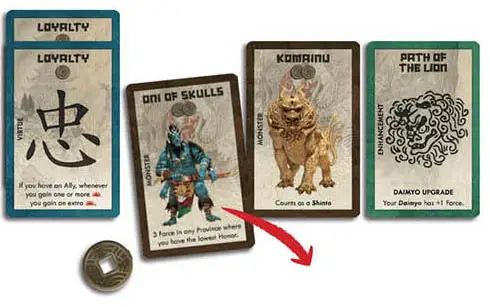
Example: The TURTLE player plays Train and is the first to choose one of the current Season cards to acquire. They choose the Oni of Skulls Monster card, which costs 2 Coins. Since they played the Mandate, the Train Bonus gives them a 1 Coin discount. They discard 1 Coin from their reserve and place the chosen card next to their Clan Screen.
Negotiation Tip
If you see an opponent 's low on Coins and there's a card they want from the Train Mandate, offering to help cover the cost of the card can be a very strong bargaining tool.
Acquiring Monsters
When a player acquires a Monster Season card, they not only place the card next to them, but they also take the corresponding Monster figure, attach a counter base of their Clan color to it, and immediately Summon it to any Province where they have a Stronghold.
The Monster now counts as one of that Clan's figures, just like its Daimyo, Shinto, and Bushi, and has 1 Force, unless otherwise stated . If it's killed, it returns to their reserve and may be Summoned again to the Map just like a normal Clan figure . There is no limit to the number of Monsters a Clan may have.
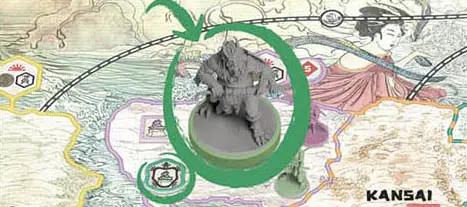
The TURTLE player then attaches a counter base of their color to the Monster figure and immediately Summons it to a Province where they have a Stronghold.
Harvest

The Harvest Mandate allows players to gain some Coins and maybe reap the rewards offered by the Provinces they control.
All Players
The player gains 1 Coin, taking it from the common pile.
Current Player And Their Ally
The player collects the Rewards listed for every Province where they currently have the most Force. Check each Province, one by one, adding together the Force provided by each Clan's figures.
The player only gets the Rewards of the Provinces where their figures have more Force than any other Clans in that Province. As always, if there's a tie, the tied player with the highest Honor is considered to have the most Force in the Province.
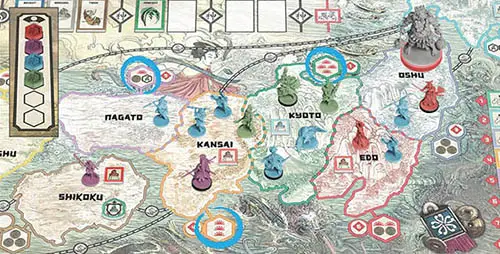
Example: The DRAGONFLY player plays Harvest and automatically gains a Coin. They then perform the Mandate Bonus, checking all Provinces where they have any presence to see where they have the most Force: Nagato - They are the only Clan with Force there, so they get a Victory Point, a Coin, and a Ronin token. Kansai - They have 2 Force there, while LOTUS and TURTLE only have 1 Force each. DRAGONFLY gets 3 VP.
Kyoto - They have 2 Force while TURTLE also has 2 Force there. Since DRAGONFLY currently has higher Honor than TURTLE , they get another 4 VP. Edo - Both DRAGONFLY and KOI have 1 Force there. Since KOI has higher Honor, DRAGONFLY gets no Harvest Reward for Edo. Oshu - KOI has 2 Force there, while DRAGONFLY has only 1, so they get no Reward.
Negotiation Tip
With Harvest, timing is everything. If you are in a situation where you'll reap a very bountiful Harvest, it might be worth it to promise some of the upcoming Coin and Ronin rewards to your Ally if they will play a Harvest right away.
The Rewards each Province may offer are:
Victory Point - Move your Clan marker up 1 slot on the Victory Point Track at the bottom of the board.
Coin - Take 1 Coin from the common pile.
Ronin - Take 1 Ronin token from the common pile.
Betray
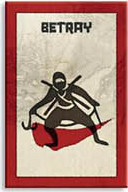
Unlike the other Mandates, Betray only benefits the current player, as they sway their opponents' figures to their cause, causing irreparable rifts in any Alliance. This is a powerful and dangerous Mandate that should not be played lightly.
If the player is in an Alliance , this Alliance is immediately broken and the Betraying player loses Honor. If the Betraying player was not in an Alliance, they do not lose Honor.
When playing Betray , the player chooses up to 2 figures on the Map, belonging to 2 different players, and immediately replaces them with figures of the same type that they have in their own Reserve. You cannot replace 2 figures belonging to the same player, replace an opponent's figure with one of yours that is already on the board, or replace an opponent's figure with one from your Reserve that's a different type. Note that a Monster in Reserve can be used to replace another Monster. Even though they have different names, they are the same type of figure.
The replaced figures are returned to their owners' Reserves (though they are not considered to have been killed). Note that if the player just broke their Alliance, they don't necessarily have to replace one of the figures of their former Ally.
Daimyo figures cannot be affected by Betrayal.
Shinto figures on the Shrines are not affected by Betrayal (unlike any on the Map).
The player cannot replace a figure if they don't have a figure in reserve of the same type.
Replacing a figure is not considered a Summon (SHINTO cannot be sent to worship).
Negotiation Tip
Even when Betraying, there is an opportunity for forceful negotiation. You have the power of removing almost any figure from the Map. How about making some requests in exchange for sparing an opponent's valuable asset?
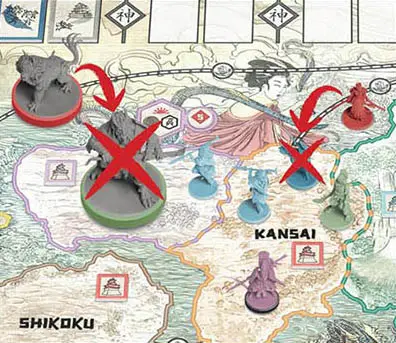
Example: After playing Betray, the KOI player replaces the TURTLE 's Oni of Skulls Monster with the Komainu Monster they had in their Reserve, and replaces the DRAGONFLY Bushi with one of the Bushi from their Reserve.
Continue Reading

